
 |
AGRICULTURE |
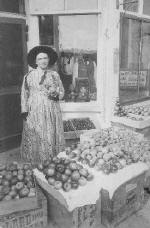 |
1880s Kate Harlow and her husband, John Petal Harlow, had one of the first farms on Rapid Creek. They experimented with a wide range of grains, vegetables and fruit, and nearly everything grew well. Kate had an early restaurant and fruit stand on Grand Junction�s Main Street. |
|
|
|
|
 |
1900s Selling our fruit to distant markets became a large business. The Colorado Fruit and Commercial Company and the Grand Junction Fruit Growers Association were two of the largest firms. The Fruit Growers Association, shown here, also evaporated fruit, which is superior to drying. For example, in 1904 they processed 244,466 pounds of Italian prunes in their evaporator building. This yielded 92,207 pounds of concentrated fruit, without moisture. |
|
|
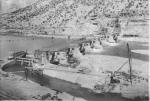 |
1910s
One of the
largest irrigation projects in the nation, the Highline Project was
completed in 1918. It provided the water to cultivate 50,000 acres in the
Grand Valley. The unusual roller dam is shown as it was being built across
the Colorado River in DeBeque Canyon. The level of the reservoir behind it
is controlled by raising or lowering large steel cylinders, called rollers.
There are only three roller dams in the country, and this is the largest.
|
|
|
 |
1920s
The vast
orchards in the Grand Valley needed chemical sprays to control insects.
General agriculture also used sprays for weeds and insects. The
Latimer-Goodwin Chemical Company manufactured and distributed sprays and
fertilizers, and had a branch in the fruit growing areas of the state of
Washington. They also made cider from apples, and fermented vinegar. |
|
|
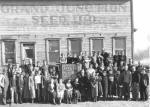 |
1930s Farmers needed seeds for their many crops, and the Grand Junction Seed Company with its Mile High Seed brand was a main supplier. The Grand Valley is superior for various crops. Red clover is an example, and the seed company would contract with farmers to grow clover for tons of seeds which were sold locally as well as nationally. They exported and imported a wide variety of seeds, including flower seeds and bulbs. (Dean Photo) |
|
|
 |
1940s World War II put the entire national economy into high gear, and agricultural production and prices were boosted out of the Depression doldrums. Mesa County fruit, livestock and field crop production flourished. Canning factories, like the large Kuner-Empson facility, operated at full capacity. It was located on South Eighth Street near the railroad. Click for larger image. |
|
|
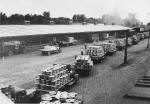 |
1950s Fruit from the Grand Valley continued its reputation for top quality. The peach orchards produced record crops at good prices. There were 900,000 trees and more than 800 orchards. However, pear and apple orchards continued to be replaced by general farming, and subdivisions continued to encroach on prime agricultural lands. |
|
|
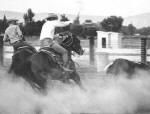 |
1960s Cattle, sheep and horses were characteristic of ranches surrounding Grand Junction. In the West, riding and roping skills led to rodeo competitions. They evolved into dramatic professional rodeos, such as the Colorado Stampede Rodeo, sponsored annually by the Mesa County Sheriff�s Posse at the Fairgrounds on Orchard Mesa. (Mesa County Sheriff�s Posse Photo) |
|
|
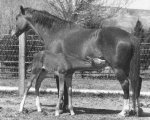 |
1970s Horses for farming and transportation mainly were replaced by cars and trucks in the early 1900s. In the Grand Valley, horses began to be used more widely for recreation. Well bred, highly trained steeds began to be raised on the acres of profitable horse farms. Hunting, trail rides, dressage, and the Sheriff's Posse were enjoyed by riders and their mounts. (The Daily Sentinel) |
|
|
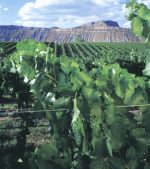 |
1980s The agricultural conditions which ensure prime fruit in the Grand Valley, also produce premium grapes. In the 1980s, serious planting of vineyards for wine grapes began around Palisade, and wineries were established. Prize vintages are being developed, and the wineries also are a tourist attraction. Viticulture now is branching out to other areas of the Grand Valley. (Photo taken at Grande River Vinyards, Palisade, Colorado, 1999, photo by Jack Dykinga.) |
|
|
|
|
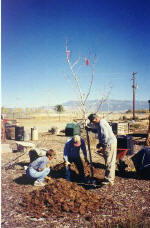 |
2000 & Beyond Gardeners benefit from the Master Gardener program of the Colorado State University Cooperative Extension on Orchard Mesa. This center, and two others in the valley, are of great value to area agriculture. Master Gardeners learn improved ways to cultivate their yards and trees, fruit and vegetables for maximum yield and quality. They also mentor new apprentices. (Colorado State University Extension Service) |
|
|
|
|
If you have
arrived at this page from a search engine |
|